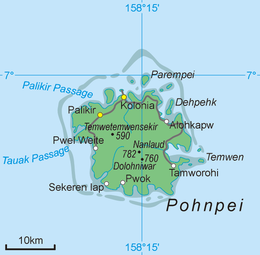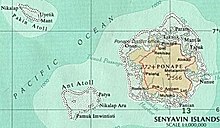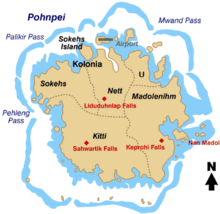Pohnpei
 Map of Pohnpei | |
| Geography | |
|---|---|
| Coordinates | 06°54′00″N 158°13′30″E / 6.90000°N 158.22500°E |
| Archipelago | Senyavin Islands |
| Adjacent to | Pacific Ocean |
| Area | 334 km2 (129 sq mi) |
| Highest elevation | 782 m (2566 ft) |
| Highest point | Mount Nanlaud |
| Administration | |
| State | Pohnpei |
| Largest settlement | Kolonia (pop. 6,074) |
| Demographics | |
| Population | 36,832 (2020) |

Pohnpei (formerly known as Ponape or Ascension, from
Pohnpei is home to the megaliths and ruined city of Nan Madol, built of artificial islands off the island's eastern shore beginning in the 8th or 9th century. An important archaeological site, it was declared a national historic site in 1985.
Pohnpei contains a wealth of biodiversity. It is one of the wettest places on Earth with annual recorded rainfall exceeding 7,600 mm (300 in)[1] each year in certain mountainous locations. It is home to the ka tree (Terminalia carolinensis) found only in Pohnpei and Kosrae.[2]
Name
The name Pohnpei comes from the Pohnpeian language, literally meaning "upon a stone altar". It derives from a Proto-Chuukic-Pohnpeic phrase *fawo ni pei of the same meaning. Cognates in other Micronesian languages include Mokilese Pohnpei and Chuukese Fóónupi.[3]
Geography


The highest point of the island is
The only land reptiles are a few species of lizard. Originally the only mammals were bats. Pigs, rats and dogs were introduced; pigs have become feral. The lagoons are rich in fish, molluscs, turtles and other marine fauna.
Climate


Pohnpei belongs to the tropical rainforest climate zone (Köppen: Af).[4] It is one of the wettest places on Earth with an average annual recorded rainfall of 4,775 mm (188.0 in) in towns along the coast and about 7,600 mm (300 in) each year in certain mountainous locations.[5]
| Climate data for Pohnpei | |||||||||||||
|---|---|---|---|---|---|---|---|---|---|---|---|---|---|
| Month | Jan | Feb | Mar | Apr | May | Jun | Jul | Aug | Sep | Oct | Nov | Dec | Year |
| Mean daily maximum °C (°F) | 30 (86) |
30 (86) |
30 (86) |
30 (86) |
30 (86) |
30 (86) |
30 (86) |
31 (87) |
31 (87) |
31 (87) |
31 (87) |
30 (86) |
30 (86) |
| Mean daily minimum °C (°F) | 23 (73) |
24 (75) |
24 (75) |
23 (73) |
23 (73) |
23 (73) |
22 (71) |
22 (71) |
22 (71) |
22 (71) |
23 (73) |
23 (73) |
22 (71) |
| Average precipitation mm (inches) | 310 (12.1) |
260 (10.2) |
360 (14) |
450 (17.6) |
490 (19.4) |
420 (16.6) |
440 (17.2) |
410 (16.3) |
400 (15.9) |
410 (16.2) |
400 (15.9) |
420 (16.7) |
4,770 (187.8) |
| Source: Weatherbase[6] | |||||||||||||
History
The natives of Pohnpei, especially the 'older' generations, often refer to events in their past as having occurred, e.g., in "German times" or "before the Spaniards," which identifies the historical periods:[7]
| Period | Years |
|---|---|
| Native Period | Before 1825 |
| Pre-Spanish Period | 1825–1886 |
| Spanish Period | 1886–1899 |
| German Period | 1899–1914 |
| Japanese Period | 1914–1945 |
| US Period | 1945–1986 |
| Independence Period | Since 1986 |
Pre-colonial history
The earliest settlers were probably
Pohnpeian historic society was highly structured into five tribes, various clans and sub-clans; each tribe headed by two principal chiefs. The tribes were organized on a feudal basis. In theory, "all land belonged to the chiefs, who received regular tribute and whose rule was absolute." Punishments administered by chiefs included death and banishment. Tribal wars included looting, destruction of houses and canoes and killing of prisoners.[7] Pre-Spanish population estimates are deemed unreliable.[7]
Earliest European contacts
Pohnpei's first European visitor was Spanish navigator Álvaro de Saavedra on 14 September 1529 shortly before his death, when trying to find the way back to New Spain.[17] He charted it as San Bartolomé and called this one and the surrounding islands as Los Pintados (literally, "the painted ones" in Spanish) because the natives were frequently tattooed. It was later visited by the navigator Pedro Fernandes de Queirós, commanding the Spanish ship San Jeronimo.[7] on 23 December 1595; his description is brief, he made no attempt to land.[18]
19th-century visitors
There is good documentation about Australian sailor John Henry Rowe, who arrived in his barque John Bull on 10 September 1825, though he did not land as his vessel was chased off by native canoes. The first lengthy description of the island and its inhabitants is presented by the Russian explorer
Miscreants and missionaries
From this time onward, whaling and trading vessels came in increasing numbers. Very soon a "large colony of beachcombers, escaped convicts, and ship's deserters became established ashore," identified as "chiefly bad characters," according to the log of the Swedish frigate Eugenie.
A drastic population decline occurred after 1854, due to a smallpox epidemic.[7]
During the American Civil War, to counteract the United States blockade of their ports, Confederate States Navy ships hunted Yankee merchant shipping. On 1 April 1865, the CSS Shenandoah surprised four United States whalers at Ascension Island (Pohnpei) and destroyed them all. The local king, Nananierikie, was delighted to receive much of the spoils from this action.[20]
Spanish rule
By 1886 the Spaniards claimed the Caroline Islands which were part of the
German rule and land reform
During the German administration a fundamental change in land ownership was implemented on Pohnpei and throughout the Carolines. Beginning in 1907, the feudal system, in which all land is held in fief, was gradually replaced with the issuance of individual deeds to land. The chief's economic advantages were thus reduced, and only force of tradition granted a first harvest tribute to chiefs.[7]
With land holding, taxes came due and new owners, in lieu of payment, were obliged to work 15 days per year on public projects, such as wharf construction, road building, etc. One such work for taxes engagement sparked the
The German census of 1911–12 shows 3,190 Pohnpeians, 585 Central Carolinians and 279 Melanesians. Many of the outer islands were resettled (mainly on Sokehs Island) as a consequence of destructive typhoons in their home islands.
A special census conducted in late 1947 shows a total population of 5,628, of which 4,451 were Pohnpeians, and 1,177 were natives of other Pacific islands. By 1963, the population had grown to nearly 10,000.[7]
Japanese rule
With the
The island was shelled on several occasions, including by the battleships USS Massachusetts, USS Alabama, and USS Iowa, as well as air attacks launched from USS Cowpens. After the war, Japanese nationals were repatriated to Japan by the US Navy.
United States administration, under United Nations oversight
The Federated States of Micronesia achieved independence in 1986 after being administered by the United States under UN auspices since 1947 as part of the Trust Territory of the Pacific Islands.
Demographics
The population of the state in 2010 was approximately 36,196. While the majority of the population consider themselves ethnic Pohnpeians, Pohnpei is more
Languages

The Pohnpeian language (formerly called "Ponapean") and its dialects are the indigenous languages of Pohnpei. The Federated States of Micronesia government also uses Pohnpeian as a regional language. English and Spanish are spoken in the island.
Administrative divisions

The municipalities on the island of Pohnpei are:
- Kitti, southwest. Includes Ant Atoll
- Kolonia, north
- Madolenihmw, east
- Nett (main island, north/center, formerly including state capital Koloniaon the north coast)
- Sokehs, northwest. Also includes Pakin Atoll and Palikir, the national capital
- U, northeast
Transportation

Pohnpei International Airport (IATA code PNI) is located near Kolonia, on a small island named Deketik off the northern coast of the main island.
Sport
The FSM is part of the international Olympic movement, originally the work of James Tobin, who now sits on the IOC Executive Board, sending teams to the summer games beginning in 2000 with the Sydney games and continuing every four years to the present with athletes participating in track and field, swimming and weightlifting. The most notable Pohnpeian athlete is marathon runner
Pohnpei's state football team were coached by the world's youngest national football coach, the Englishman Paul Watson, who led the team on a tour of nearby Guam, winning one match against a local team. [23] The annual Micronesian Futsal Cup has been established on the island, also the work of Watson.
Pohnpei in fiction
Pohnpei (as Ponape) plays a role in several stories of the
Pohnpei is a central location in South Sea Adventure (1952), the second of Willard Price's Young Adult Adventure Series books featuring Hal and Roger Hunt.[citation needed][25]
Pohnpei, or "Ponape" as it is spelled, is stated as the home island of "Mike" on the popular blog Dunce Upon A Time, authored by BC Woods.[26]
Education
Pohnpei State Department of Education operates public schools.
Public high schools:[27]
- Nanpei Memorial High School a.k.a. Kitti High School
- Madolenihmw High School
- Pohnpei Island Central School (former Pacific Island Central School) in Nett
Private schools:
- Calvary Christian Academy in Kolonia[27]
- Ohwa Christian High School in Madolenihmw[27]
- Our Lady of Mercy Catholic High School in Kolonia[28]
- Seventh Day Adventist High School in Nett[27]
Pohnpei Catholic School
Post Secondary Education:
- College of Micronesia-FSM, which has a state campus in each of the four states with its national campus in the capital city of Palikir. The COM-FSM system also includes the Fisheries and Maritime Institute (FMI) on the Yap islands.
Lidorkini Museum was located in Kolonia, until its closure in 2012.[29]
Notable residents
- Debra Daniel – Olympic swimmer
- Iris Falcam – Librarian and former First Lady of Micronesia
- Leo Falcam – Former President of Micronesia
- Kerson Hadley – Olympic swimmer
- Emelihter Kihleng – Poet
- Bailey Olter – Former President of Micronesia
- Elias Rodriguez – Olympic marathon runner
- Mihter Wendolin – Olympic sprinter
Gallery
-
Flag of Pohnpei
-
Pwusehn Malek (also known as Chickenshit Mountain) in Pohnpei
-
Pohnpei lorikeet
-
Pohnpei flycatcher
-
Pohnpei Airport
-
Petroglyphs
See also
Notes
- ^ The Saudeleur era lasted around 500 years.[10] Legend generally dates their downfall to the 1500s,[11] however, archaeologists date Saudeleur ruins to c. 1628.[12][13][14]
- ^ "they had set forth for the Nan-Matal, that extraordinary group of island ruins clustered along the eastern shore of Ponape in the Carolines"
References
- ^ "Rainfall Climatology for Pohnpei Islands, Federated States of". Archived from the original on 21 February 2022. Retrieved 3 March 2022.
- Nature ConservancyMagazine February / March 2015 page 36
- S2CID 201778237.
- ^ "Archived copy". Archived from the original on 8 November 2014. Retrieved 16 January 2015.
{{cite web}}: CS1 maint: archived copy as title (link) - ^ "Archived copy" (PDF). Archived from the original (PDF) on 4 March 2016. Retrieved 8 November 2014.
{{cite web}}: CS1 maint: archived copy as title (link) - ^ "Weatherbase: Historical Weather for Pohnapei, Federated States of Micronesia". Weatherbase. 2011. Archived from the original on 24 March 2020. Retrieved 24 November 2011.
- ^ ISBN 9780598442437. Retrieved 1 January 2012.
- .
- ISBN 1-57306-129-8. Archivedfrom the original on 7 October 2022. Retrieved 1 January 2012.
- ^ ISBN 0-8248-1124-0. Retrieved 1 January 2012.
- ISBN 0-8248-1134-8. Archivedfrom the original on 7 October 2022. Retrieved 31 December 2011.
- ISBN 0-292-76506-1. Retrieved 31 December 2011.
- ^ ISBN 1-57306-166-2. Retrieved 31 December 2011.
- ^ Micronesica. University of Guam. 1990. pp. 92, 203, 277. Archived from the original on 7 October 2022. Retrieved 31 December 2011.
- ISBN 0-671-24030-7. Archivedfrom the original on 7 October 2022. Retrieved 31 December 2011.
- hdl:10125/15545. OP35. Archived(PDF) from the original on 27 January 2012. Retrieved 31 December 2011.
- ^ Brand, Donald D., The Pacific Basin: A History of its Geographical Explorations, The American Geographical Society, New York, 1967, p.137
- ^ Coello, Francisco "Conflicto hispano-alemán" Boletín de Sociedad Geográfica de Madrid, t.XIX. 2º semestre 1885, Madrid, pp.244,245,294,296
- ^ a b Bunson, Maggie. Faith in Paradise. Boston: St. Paul Publishing. 1977, pp. 43, 65
- ^ CSS Shenandoah, Lieutenant James I Waddell, Annapolis 1960, pages 144-155
- ^ a b Takizawa, Akira; Alsleben, Allan (1999–2000). "Japanese garrisons on the by-passed Pacific Islands 1944–1945". Forgotten Campaign: The Dutch East Indies Campaign 1941–1942. Archived from the original on 6 January 2016.
- ^ Pucin, Diane (2 October 2000). "G'Bye, Mates". Los Angeles Times. Archived from the original on 2 September 2017.
- ^ name="FIFA20131223">"Micronesia to Mongolia: A coaching quest". FIFA.com. 23 December 2013. Archived from the original on 23 December 2013. Retrieved 18 January 2024.
- ^ Lovecraft, H.P. "Out of the Aeons". Archived from the original on 25 July 2014. Retrieved 16 July 2014.
- ^ ""south sea adventure" in a sentence – south sea adventure sentence examples – ichacha.net sentence maker". eng.ichacha.net. Archived from the original on 23 February 2018. Retrieved 22 February 2018.
- ^ "The Micronesian Elvis". Dunce Upon A Time. 30 August 2007. Archived from the original on 2 December 2008. Retrieved 17 August 2009.
- ^ a b c d "Higher Education in the Federated States of Micronesia Archived 14 October 2017 at the Wayback Machine." Embassy of the Federated States of Micronesia Washington DC. Retrieved on 23 February 2018.
- ^ "Come Visit Us Archived 23 February 2018 at the Wayback Machine." Our Lady of Mercy Catholic High School. Retrieved on 23 February 2018. "The school is located on the Catholic Mission in Kolonia near the Spanish Wall"
- ^ "Green Travel Guide to Micronesia – How to Visit Sustainably". ecofriendlytravels.com. Archived from the original on 16 July 2021. Retrieved 16 July 2021.
Further reading
- The Island of the Colour-blind, Oliver Sacks, Publisher: Pan Macmillan (6 June 1997), paperback, ISBN 0-330-35234-2.
- Pohnpei, an Island Argosy, Gene Ashby, Publisher: Rainy Day Pr West; Revised edition (June 1987), paperback, ISBN 978-0-931742-14-9
- Nest in the Wind: Adventures in anthropology on a tropical island, Martha C Ward, Publisher: Waveland Press Inc. (1989), paperback, ISBN 0-88133-405-7
- Thomas Morlang: Rebellion in der Südsee. Der Aufstand auf Ponape gegen die deutschen Kolonialherren 1910-1911, Christoph Links Verlag, Berlin, Germany ISBN 9783861536048
- David Childress. "The Lost City of the Pacific". Omega Science Digest (March 1986), pp. 48–55, 121.
External links
- POHNPEI, un estado marítimo-insular en el Océano Pacífico. 1. (in Spanish)
- POHNPEI, uno de los cinco estados que integran la FSM. 2. (in Spanish)
- POHNPEI (Islas Carolinas orientales). 3º parte. (in Spanish)
- Los atolones occidentales de Pohnpei (Estados Federados de Micronesia). 4ª parte. (in Spanish)






